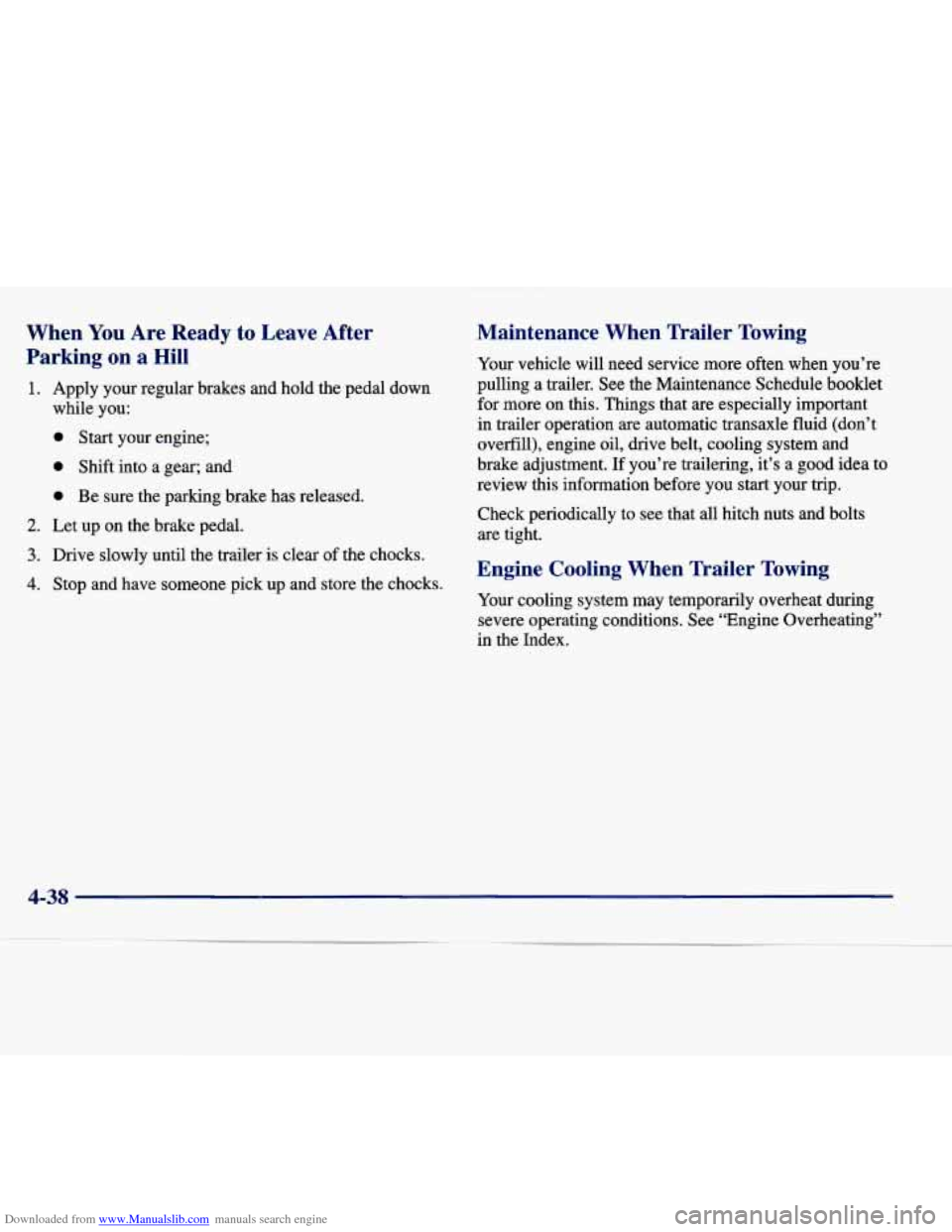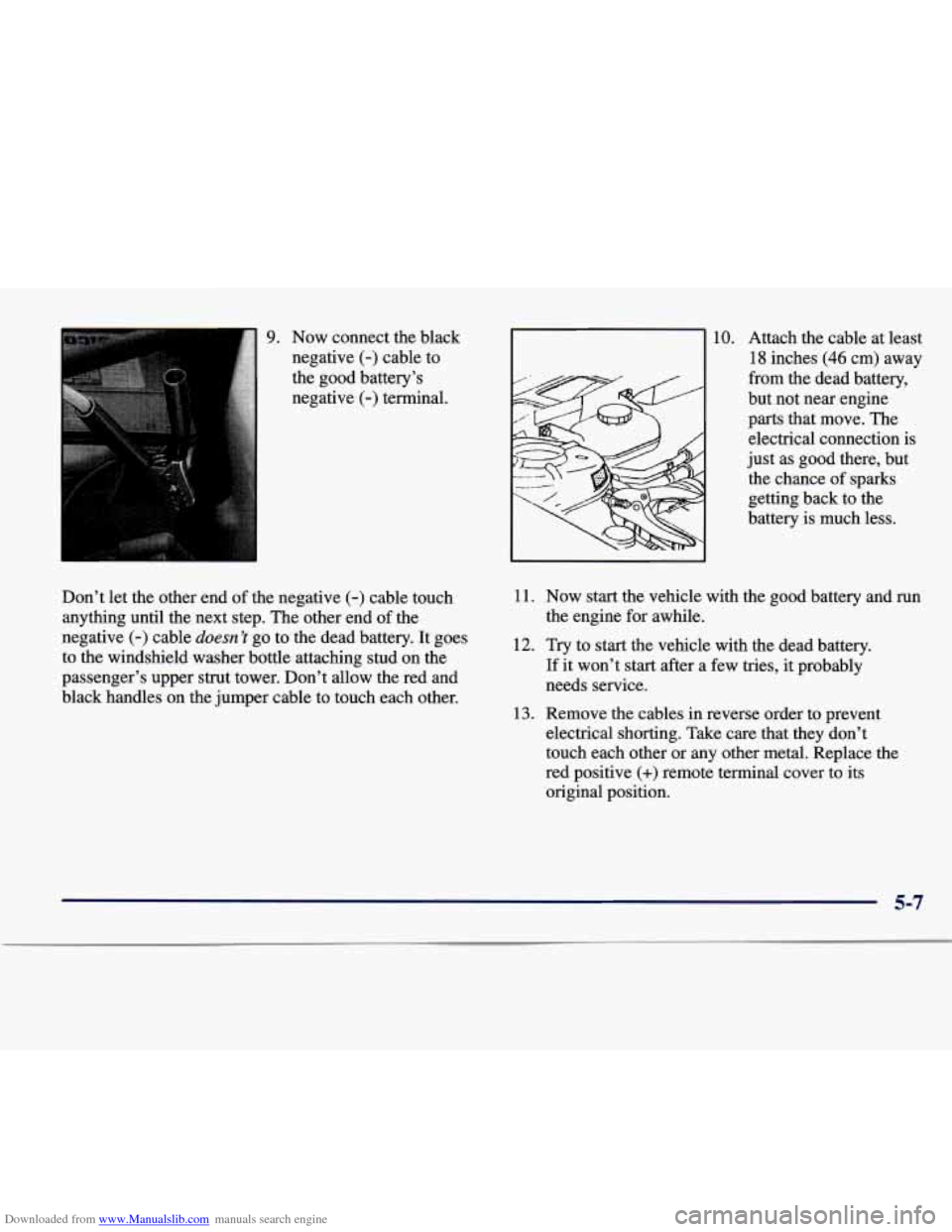Page 234 of 378

Downloaded from www.Manualslib.com manuals search engine Turn Signals When Towing a Trailer
When you tow a trailer, your vehicle may need a
different turn signal flasher and/or extra wiring. Check
with your Cadillac dealer. The green arrows on your
instrument panel will flash whenever you signal a turn
or lane change. Properly hooked up, the trailer lamps
will also flash, telling other drivers you’re about to turn,
change lanes or stop.
When towing a trailer, the green arrows on your instrument panel will flash for turns even if the bulbs
on the trailer are burned out. Thus, you may think
drivers behind you are seeing your signal when they
are not. It’s important to check occasionally to be sure
the trailer bulbs are still working.
Driving On Grades
Reduce speed and shift to a lower gear before you start
down a long or steep downgrade. If you don’t shift
down, you might have to use your brakes
so much that
they would get hot and no longer work well.
On long uphill grades, reduce speed to 45 to 50 mph
(70 to 90 km/h) and avoid prolonged use of
SECOND (2) gear and engine speeds above 3800 rpm. Climbing grades steeper than 4 degrees at temperatures
above
90°F (32 “C)
with a loaded vehicle and trailer is
not recommended. The cooling system may temporarily
overheat. See “Engine Overheating” in the Index.
Parking on Hills
You really should not park your vehicle, with a trailer
attached, on a hill. If something goes wrong, your rig
could start to move. People can be injured, and both
your vehicle and the trailer can be damaged.
But if you ever have to park your rig on a hill, here’s
how to do it:
1. Apply your regular brakes, but do not shift into
PARK (P).
2. Have someone place chocks under the trailer wheels.
3. When the wheel chocks are in place, release the
regular brakes until the chocks absorb the load.
4. Reapply the regular brakes. Then shift into
PARK (P) firmly and apply your parking brake.
5. Release the regular brakes.
4-37
Page 235 of 378

Downloaded from www.Manualslib.com manuals search engine When You Are Ready to Leave After
Parking on a Hill
1. Apply your regular brakes and hold the pedal down
while you:
0 Start your engine;
0 Shift into a gear; and
0 Be sure the parking brake has released.
2. Let up on the brake pedal.
3. Drive slowly until the trailer is clear of the chocks.
4. Stop and have someone pick up and store the chocks.
Maintenance When Trailer Towing
Your vehicle will need service more often when you’re
pulling a trailer. See the Maintenance Schedule booklet
for more on this. Things that are especially important
in trailer operation are automatic transaxle fluid (don’t
overfill), engine oil, drive belt, cooling system and
brake adjustment.
If you’re trailering, it’s a good idea to
review this information before you start your trip.
Check periodically to see that all hitch nuts and bolts
are tight.
Engine Cooling When Trailer Towing
Your cooling system may temporarily overheat during
severe operating conditions. See “Engine Overheating’’
in the Index.
4-38
Page 238 of 378
Downloaded from www.Manualslib.com manuals search engine ,*a- -a
Section 5 Problems on the Road
Here you’ll find what to do about some problems that can occur on the road.
5-2
5-3
5-3
5-8
5- 15
Hazard Warning Flashers Other Warning Devices
Jump Starting
Towing Your Vehicle
Engine Overheating 5-24 If a Tire Goes Flat
5-24 Changing a Flat Tire
5-35 Compact Spare Tire
5-36 If You’re Stuck: In Sand, Mud, Ice or Snow
Page 244 of 378

Downloaded from www.Manualslib.com manuals search engine 9 I’ L 9. Now connect the black
negative
(-) cable to
the good battery’s
negative
(-) terminal.
Don’t let the other end
of the negative (-) cable touch
anything until the next step. The other end
of the
negative
(-) cable doesn ’t go to the dead battery. It goes
to the windshield washer bottle attaching stud on the
passenger’s upper strut tower. Don’t allow the red and
black handles on the jumper cable to touch each other.
VI 18 inches (46 cm) away
10. Attach the cable at least
from the dead battery,
but not near engine
parts that move. The
electrical connection is
just as good there, but
the chance
of sparks
getting back to the
battery is much less.
11. Now start the vehicle with the good battery and run
the engine for awhile.
12. Try to start the vehicle with the dead battery.
If it won’t start after a few tries, it probably
needs service.
13. Remove the cables in reverse order to prevent
electrical shorting. Take care that they don’t
touch each other or any other metal. Replace the
red positive
(+) remote terminal cover to its
original position.
5-7
Page 245 of 378

Downloaded from www.Manualslib.com manuals search engine L II \
A. Remote Positive (+) Terminal
B. Good Battery
C. Windshield Washer Bottle Stud (not shown in
picture--located on the passenger’s side corner of the engine compartment)
Towing Your Vehicle
Try to have a dealer or a professional towing service tow
your vehicle. See “Roadside Service” in the Index.
If your vehicle has been changed or modified since it
was factory-new by adding aftermarket items like-fog
lamps, aero skirting or special tires and wheels, these instructions may not be correct.
Before you do anything, turn on the hazard warning flashers.
When you call, tell the towing service:
0 That your vehicle ha$ front-wheel drive.
0 The make, model and year of your vehicle.
0 Whether you can still move the shift lever.
0 If there was an accident, what was damaged.
When the towing service arrives, let the tow operator
know that this manual contains towing instructions and
illustrations. The operator may want to see them.
Page 246 of 378
Downloaded from www.Manualslib.com manuals search engine I A 3
I /!1 CAUTION:
To help avoid injury to you or others:
a
Never let passengers ride in a vehicle that is
being towed.
Never tow faster than safe or posted speeds.
Never tow with damaged parts not
fully secured.
Never get under your vehicle after it has
been lifted by the tow truck.
Always secure the vehicle on each side with
separate safety chains when towing it.
Never use J-hooks. Use only T-hooks in the
front T-hook
slots and only R-hooks in the
rear R-hook slots.
Page 247 of 378

Downloaded from www.Manualslib.com manuals search engine A vehicle can fall from a car carrier if it isn’t
adequately secured. This can cause
a collision,
serious personal injury and vehicle damage. The
vehicle should be tightly secured with chains or
steel cables before it
is transported.
Don’t use substitutes (ropes, leather straps,
canvas webbing, etc.) that can be cut by sharp
edges underneath the towed vehicle. Always use
T-hooks inserted in the front T-hook slots or
R-hooks inserted in the rear R-hook slots. Never
use J-hooks. They will damage drivetrain and
suspension components.
NOTICE:
Don’t have your vehicle towed on the drive
wheels unless you must.
If the vehicle must be
towed on the drive wheels, be sure to follow the
speed and distance restrictions later in this
section or your transaxle will be damaged.
If
these limitations must be exceeded, then the drive
wheels have to be supported on a dolly.
The steering wheel should be clamped in a
straight-ahead position, with a clamping device
designed
for towing service. The transaxle should be in
NEUTRAL (N) and the parking brake released.
5-10
Page 248 of 378
Downloaded from www.Manualslib.com manuals search engine Front Towing
NOTICE:
Do not tow with sling-type equipment or
fascidfog lamp damage will occur. Use wheel-lift
or car-carrier equipment. Additional ramping
may be required for car-carrier equipment. Use
safety chains and wheel straps.
Towing a vehicle over rough surfaces could
damage a vehicle. Damage can occur from vehicle
to ground or vehicle
to wheel-lift equipment. To
help avoid damage, install a towing dolly and
raise the vehicle until adequate clearance is
obtained between the ground and/or
wheel-lift equipment.
Do not attach winch cables or J-hooks to
suspension components when using car-carrier
equipment. Always use T-hooks inserted in the
T-hook slots.
5-11